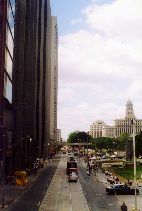
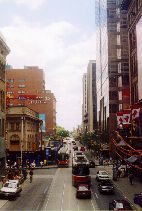
QUEEN STREET
Themes, in transit
Passing stories
Tales from a wander
so far without end
Urbanologist and fellow citizen Jane Jacobs once said that if you want to know how the world around you works, "you've got to get out and walk." I have spent most of my life walking this town, looking around, rarely with any particular focus.
In April 2001, pondering what urban citizenship offers us -- and asks of us, I decided it was time for a more thoughtful wander. I made my focus one street, for its length, its long history, its crazed variety -- and its streetcar: ten miles is a long way to walk.
Those streetcars symbolize (even embody) a vital fact about Queen Street: it is a route of civic amenity. Public services, civil institutions -- under threat as governments sell off civil works in the name of private, corporate "efficency." I wanted to celebrate the street as a place of public lives, communal endeavours, collective urban citizenship.
I have: writing about (among other things) public transit, public works, public spaces and structures, even "public" sex. But I have also found other themes.
I had not planned a public launch of these stories until I had all of them done. But that, I see now, will not be any time soon. And, while I have hung these tales off the line of a single street, they do not have to be read as one long linear narrative: each is meant to make sense, more or less, on its own.
For some I used Queen as a vantage point, looking more widely at Toronto and its history. Otherswere tours directly along the street, crossing eight neighbourhoods west to east (Parkdale; Liberty, Trinity & Niagara; Queen West; Downtown; Moss Park, Corktown & Trefann Court; South Riverdale & Leslieville; Ashbridge's Bay; The Beach), and one river (the Don). Most were side tours, topical and historical, taking off from those neighbourhoods.
You'll find 17 of those stories here on preview -- grouped not by neighbourhood as I finally intend, but by broad (and overlapping) themes: Land; Empire; Spaces; Bodies; and Cultures.
You'll also find an introduction written just after I began this project, here given its own theme: Streetwalking. And excerpts from an introduction I did for a preview posted in April 2002 (all its stories included here). Here that's called "Class acts," reflecting another theme I discovered along the way. You'll find it here under Bodies.
Page headings on stories show where each will finally fit on, or off, the line of Queen Street. But that line itself is mostly not here: nearly all these tales are streetwide, or side tours; only one is a tour along Queen. The rest, I've decided, should wait until I know where they'll lead (the street ever changing) and what, in time, I have learned.
That end is a long way off: I'm just halfway there. I've barely got east of the Don River nor covered all the turf to its west, not even the most famed stretch of Queen West -- where, many years ago, my thoughts on urban space and true citizenship first found focus. I'm not sure when, or even if, I finally will.
So, lest my energy flag, I here pass along most of the stories I've found so far.
-- Rick Bébout / Toronto, Canada, September 2002
Note: Each story is linked to the next in the order shown below. But you can, of course, read them in any order: each also has a link leading back to this page. This site is designed to ease reading on screen, but I suggest printing out longer pieces if you can. Approximate word count and number of images are shown for each.
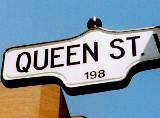
Life on the street
Thoughts on a ten-mile tour (& a few of my tour guides)
"Think of the city and what comes to mind? Its streets." That's Jane Jacobs. I chose Queen. Here I say what inspired me to it, and who helped me to truly see it: Jane herself; one-time mayor and all-time civic activist John Sewell; friends committed to urban citizenship -- and the great poet of a more fabled city, Frank O'Hara.
2,600 words / 12 images
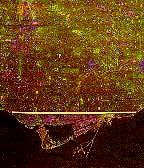
A line on a map
On the road with the Royal Engineers:
Logic confronts landscape, and wins
The origin and development of Queen Street: from a line laid down by surveyors of empire, to Lot Street with its Park Lots, still shaping the modern city. Born a road out of town (with too many names, Dundas once among them), it soon became a vibrant and varied (if still dead straight) urban thoroughfare. With maps from 1793, 1818, 1842, and 1992.
1,900 words / 4 maps
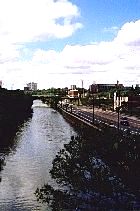
Of time & the river
The Don: salmon to sludge to concrete;
in time, to life revived
Toronto's most important if long ignored river, seen on a tour along Queen Street's stretch -- if here, one with a difference: "Step down and you're in another place." Yet still in the heart of the city.
From the Anishnawbe's Necheng-qua-kekonk, to Elizabeth Simcoe spotting salmon in 1796, to Victorian logic locking its sinuous stream in a dead-straight ditch; from early 20th century steel spanning the valley to modern efforts to "Bring Back the Don" -- the life, and times, of an urban stream (with some public art: on Time).
3,600 words / 28 images
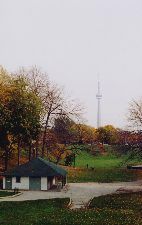
Landscapes lost, & found
Garrison Creek; downtown's other streams & ravines:
reclaiming the life beneath our feet
"Nature beneath culture," a town thinking itself flat, casting its Cartesian grid over waterways still running -- in sewers. Stories of streams, most lost to history (if some more getting more "history" than others), and citizens working to claim them, again, for our future.
With reflections on the nature (and semiology) of city parks and urban "Nature."
5,000 words / 33 images
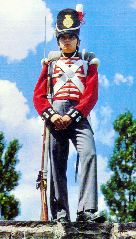
York's fort; Toronto's reserve
The Garrison: birthing, briefly losing,
& long shaping a very British town
The Simcoes' tent, their armed outpost, and its tiny town, invaded by Americans in 1813, unmolested since (at least militarily) if its garrison long standing guard. A military reserve, and cool British reserve, shaping an uptight provincial town -- and a "World City" remarkably unperturbed at its modern multicultural makeup.
From petty pretension, class distinctions, manners, mere politeness -- to true civility: thoughts on tolerance (even mere) as a high civic virtue.
9,000 words / 29 images
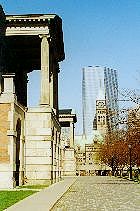
Halls of law & governance
Osgoode Hall; City Halls current, former, & long gone
Official buildings, however grand, do not a city make. But architecture is worth a look not just as "frozen music," but as concrete evidence of a city's history: its sense of itself, its aspirations, even its messy politics.
Here: the Law Society's Osgoode Hall as a detective story, with tales of rich real estate deals among the local gentry; City Halls, modest and not, some designed in contentious competitions, few built -- as that modern mantra demands -- "on budget and on time" (but who cares now?). And some later lessons in local democracy.
4,700 words / 28 images
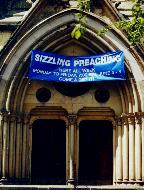
Streets of faith
Church & Bond: sizzling preachers,
divine & democratic
Toronto the Very Good, a "City of Churches," from Methodist Primitive to African Baptist to Presbyterian United Secessionist -- Orange Protestants truly united only against the Catholics.
Cathedrals actual (St James'; St Michael's) & virtual (Metropolitan); a synagogue gone Greek; a little Lutheran; rebel William Lyon Mackenzie & reformer Egerton Ryerson. A Downtown tour taking in faith's final resort: pawn shops.
3,700 words / 22 images
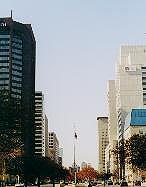
Dreams of grandeur
University Avenue: Bucolic boulevard
to monster monoliths
The evolution of an avenue, from academic greensward to sterile concrete. Illustrated with grand Beaux Arts plans of 1911, Art Deco dreams of 1929, and a few of their remaining momuments -- one saved by civic struggle.
More contending creeds (this time collegiate), conflicting visions (from Sir Adam Beck to modern Tory privatizers), and the historical antecedents of what's been called "an identity crisis with pavement": Avenue Road.
2,900 words / 17 images
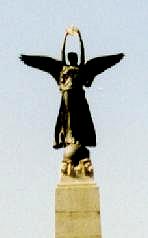
Glory of Empire
The South African War Memorial
& other monuments to lost boys
Canada's wars -- distinct from America's (some against Americans) -- recalled in bronze, stone, and the faces of boys. From Johnny Canuck off to bash the Boers, to Flanders fields, Vimy Ridge, and beyond: "We are the Dead." In their thousands.
If, each one, more glorious alive.
2,200 words / 8 images
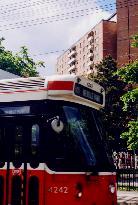
Blight & the Brave New World
The Queen Street tour, from Jarvis
Street east to the Don River
Urban renewal -- "bold ideas, radical in their day, promoted by heroic visionaries undaunted by vast efforts to eradicate urban decay." It has since, and more aptly, been called "urbicide": cold logic applied, with deadening effect, to the organic life of cities.
One of the main tours along Queen (the only one in this preview, apart from tales of the Don above), offering context for two side tours below, on communities long in the grip of master planners blind to the arrogance of power -- until they met resistance.
3,000 words / 47 images
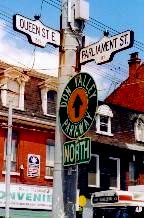
Government's house
& housing the governed
Parliament Street: Regent Park, Cabbagetown
(old & "Old"), & St James Town
A side tour off Queen, east of downtown: Ontario's first parliament gone to a parking lot; Old Cabbagetown gone to Corbusian banality; new "Old Cabbagetown" going to self-conscious twee; a "city within a city" for "young downtown professionals" become a streetless high rise no man's land.
Blockbusting, gentrification, planned ghettoization; poverty, drugs, low life -- or so the media tell us, Regent Park just another grim "project." To many who live there, it's a community worthy of care and civic energy: their own.
4,600 words / 36 images
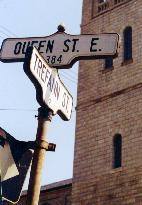
Master builders meet citizen activists
Trefann Court & beyond: from
"urban renewal" to true civic life
The people of a small Queen East community, none of whom "could be considered a professional," face down "expert" planners -- and win. Their battle began in 1966; their neighbourhood is still there, the new finding its place among the old, not obliterating it.
As John Sewell said: "Trefann Court spelled the end of urban renewal in Canada." He should know: his political education began there, leading to a term as this city's most radical mayor since William Lyon Mackenzie. Tales of civic sense blooming in the '70s -- "People City" and "Jane Jacobs neighbourhoods" -- blown away (for now, anyway) by Megacity in 1998.
3,900 words / 24 images
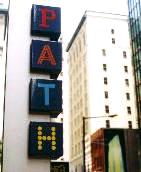
Private property; public life
The city indoors: The Eaton Centre
& "Toronto's Downtown Walkway"
The spectacle of consumer culture in arcades Walter Benjamin, noted chronicler of civic life, might have recognized: a massive mall; 10 kilometres of "street" undergound; "public" space privately owned, policed by videocams and rent-a-cops.
Busy crowds under constant surveillance, the erotic restricted to teasing ads -- yet even here life claims space, "taking root in the cracks and margins of official intent."
4,400 words / 32 images
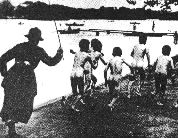
Class acts
Seeing lives through the lens of "fashionable eyewear
we don't even know we're wearing"
Good people of logical mind and noble intent, often professional -- the "expert class" -- using "others less fortunate" as fodder for the advancement of their brilliant careers. Queen and environs as a setting for social control of "the dangerous classes" -- met by the resistance of everyday acts of being.
900 words / 3 images
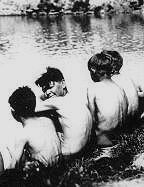
Urban amenities; erotic anxieties
Baths, lavatories, & the YMCA:
The politics of bodies in civic space
From ancient ephebes splashing in gymnasia to skinnydippers on the Don: bodies beyond domestication. Public baths from Rome to Istanbul, Paris to New York to Toronto (some literally shocking); public loos become sites of public "vice"; erotic ambiguities, gay visibility -- and big baths raids (with surprising results).
With a look at the YMCA's ironic history (and our own) of "brotherly love" gone to hardened categories of consumer sex.
7,100 words / 39 images
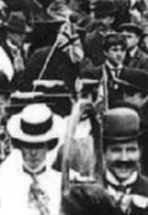
Mad for "the show"
Working girls, street boys,
& moral salvation in Toronto the Good
The booming city, 1880-1930, sees droves of independent young women working shops, factories, and the floors of Eaton's; slews of boys working the streets (in more ways than one) -- and media-driven moral panics over "white slavery" and "men of the Oscar Wilde type."
Vaudeville, burlesque, beaches, nickelodeons; boys and girls out for a good time; their vigilant guardians; a scandal monger of 1898 with a special fondness for boys (if more surely a "journalist" than "gay") -- and lives recognizable to modern gay boys, on a street named for (if not much respecting) temperance.
9,600 words / 44 images
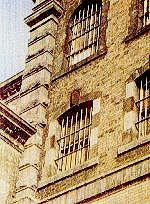
Not at liberty
Jails (& gaols), Central Prison, the Mercer
Reformatory, & the Asylum
Crime and punishment (if mostly the latter) in a side tour of a neigbourhood named Liberty, with a few penal excursions beyond.
"Incorrigible" girls taught middle class manners; "lunatics" in the grip of "doctors both divine and satantic -- beyond human measure in any case." With stories, gathered by a former mental patient, of lives held hostage from 1870 to 1940 in an institution now happy to "Celebrate LGBT Pride" (as long as correctly diagnosed) and tales, courtesy of an "escaped lunatic," of the modern Mad Movement.
8,800 words / 29 images
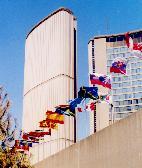
World city
Immigrant experiences & myths of diversity
Toronto is a city of immigrants -- even more so than New York. It has escaped much, if hardly all, of the racial tension seen as characteristic of "North American cities" (a meaningless category), largely through officially sanctioned diversity -- "the big tent beneath which the nice tolerate the different -- if rendered safe."
Substantially revised since its April 2002 preview launch, with comments from a noted critic of the Multicult -- and from more radical critics of his critique.
7,000 words / 9 images
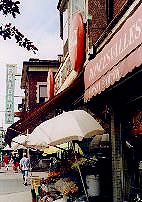
Roncesvalles
Spanish name, Polish downtown;
one avenue, many stories
Streetcar sagas, aromatic delis, the Pope of Hearts, and monuments to many lost lives: the rich, resistant culture of "God's Playground" meets (and stands to survive) cultural tourism -- on a truly good urban street, "varied, human in scale, rhythmic with life."
With thoughts on "the immigrant narrative" (official and otherwise), ambiguous heroes, mental maps, and neighbourhoods just next door as "places not quite here."
6,200 words / 32 images
You can choose any story, or begin at:
Life on the street
Or go to:
This page: http://www.rbebout.com/queen/2pass.htm
My home page
September 2002 / Last revised: November 1, 2002
Rick Bébout © 2002 / rick@rbebout.com